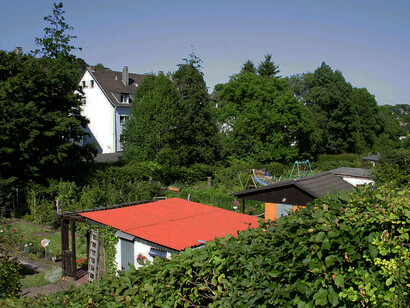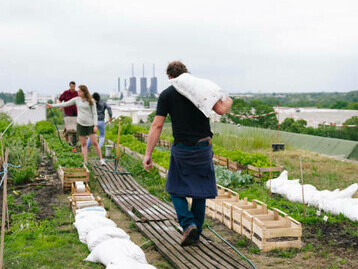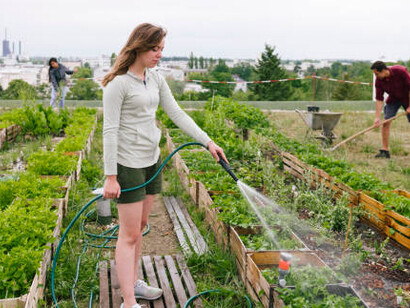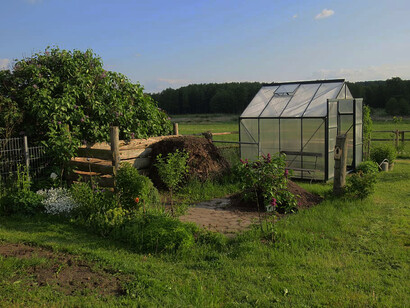Imagine the ideal: living right in the vibrant heart of a bustling city, yet stepping out your door into a tranquil garden oasis. It's a dream many of us share, this longing for urban convenience and natural escape, for the pulse of city life and the quiet of green space. This desire to reconcile urban centrality with natural escape is rarely fully attainable. Yet, in cities like Berlin, this very tension has given rise to unique urban forms, most notably, the city's sprawling allotment gardens. These garden plots exist in the in-between spaces of the city—alongside the highways, near train tracks, and in areas deemed less desirable for traditional development.
Think of them as green threads woven into the city's fabric, sometimes forming larger clusters along the routes leading into the urban core, other times appearing as small islands within the built-up environment. It's easy to miss them, perhaps, but collectively they are a significant presence. Across Berlin, there are nearly 900 of these allotment compounds, hosting over 70,000 individual gardens that, incredibly, account for over 3% of the city's entire urban landscape. A substantial portion of this green network, around 79%, is even on public land, underscoring their integration, however subtle, into the city's structure.
These seemingly simple green spaces, as Hanna Hilbrandt explores in Housing in the Margins. Negotiating Urban Formalities in Berlin's Allotment Gardens (2021) are actually complex sites where the formal structures of the city negotiate with the informal needs and practices of its inhabitants. But how did these seemingly marginal spaces become such a significant feature of Berlin's urban landscape, and how did this unique dynamic between formality and informality take root? To answer these questions, we must turn to the historical origins of Berlin's allotment gardens, tracing their development back to the late 19th century and the era of rapid industrialization.
The late 19th-century origins of Berlin's allotment gardens perfectly exemplify the inherent tension between formal urban planning and informal social practices. As Hilbrandt notes, most of Berlin's allotment compounds go back to a period of industrialization and rapid expansion of the city at the turn of the 20th century. This era was marked by a massive influx of people seeking work in burgeoning industries, leading to significant social challenges, most notably a severe housing shortage.
In response to this crisis, efforts to promote 'self-help housing' emerged, and it is within this context that Berlin's allotment gardening history began to take shape. As Hilbrandt further points out, this period saw the first 'broader wave of allotments being established' as Berlin expanded (Hilbrandt, 2021, p. 32). Such establishment reveals a crucial transition: the move from informal squatting in areas just outside the city gates to the more formalized system of dwelling in allotments.
Thus, from the outset, Berlin's allotments were born from a dual impulse: official city planning seeking to incorporate green spaces and the informal, urgent need for housing among Berlin's rapidly growing and often impoverished population. This dual original point—formal planning meeting and informal necessity—is further underscored by the very language used to describe these spaces, 'colonies.' Indeed, the beginnings of Berlin's allotment history also correspond to the era of German colonialism in Africa, between 1884 and 1920, a period referenced in the still current naming of the gardens as 'colonies.'
Such naming alludes to a center-periphery relation, as Hilbrandt observes, pointing to an understanding of the allotments as 'the periphery of the “civilized” city' (Hilbrandt, 2021, p. 36). Indeed, despite being within the city's boundaries, the allotments are often situated in marginal locations.
The term 'colony,' therefore, becomes a potent symbol of this inherent paradox. It suggests a formalized, structured space—a 'colony' within the city—yet simultaneously evokes ideas of distance, periphery, and a relationship to a 'center' that is conceptually elsewhere, more 'civilized,' more truly 'urban.' This very naming reveals the ambiguous position of allotments from their inception—formally recognized, yet conceptually and geographically on the margins.
Thus, the very beginnings of Berlin's allotment gardens demonstrate a defining characteristic that would persist throughout their history: a constant negotiation between formal integration into the urban fabric and the informal practices and needs that drove their emergence, a negotiation subtly and powerfully captured in the enduring metaphor of the 'colony,' and a dynamic that would continue to shape their everyday governance and future trajectory.
This historical analysis reveals Berlin's allotment gardens as spaces fundamentally shaped by a persistent tension between urban formalities—the city's official regulations, planning frameworks, and legal definitions—and the informal practices of residents, particularly regarding dwelling and self-provisioning. This ongoing negotiation, historically contingent and driven by forces like industrialization, war, and economic shifts, exposes inherent ambiguities and contradictions in the city's approach to governing its marginalized spaces and populations. By examining these tensions across different historical periods, we can understand how Berlin has continually (and often inconsistently) defined and managed the boundaries between the formal and informal city.
Bridging history to the present: allotments in a changing urban landscape
This persistent tension between formal regulations and informal practices in Berlin's allotment gardens is not just a matter of historical policy shifts; it is actively negotiated and managed in the everyday governance of these spaces, as Hilbrandt's research reveals. As Hilbrandt explains, the everyday governance of allotment gardens is handled not only by 'district bureaucracies but also by the gardeners' self-administered associations' (Hilbrandt, 2021, p. 103).
These associations, in effect, act as localized regulatory bodies, forming a 'political apparatus inserted between the individual gardener and the city's bureaucracy' (ibid.). Their offices are 'supposed to control the conditions of each plot, to mediate internal conflicts through their own arbitration panel, or to sue non-complying gardeners' (ibid.). This places the associations in a 'sandwiched situation,' caught between the requirements of the city administration, on the one hand, and the exigencies of the gardeners, on the other.
Hilbrandt emphasizes that 'enacting regulations is a joint effort: bureaucracies have little choice but to rely on their partners in the colonies' (Hilbrandt, 2021, p. 114). Allotment holders, in turn, are not passive recipients of rules. They can widen the room for tolerance through adapting regulations, but they also need to adhere to the rules of the game. This dynamic reveals that 'rather than differentiating formality through some boundary set by the law, the boundaries of tolerance are established through social practices' (ibid.). Therefore, what is inside or outside of a realm of consent not only relies on written statutes or fixed frames but is also determined by the ordinary compromises that negotiations bring about.
This intricate system of everyday governance, where formality is constantly negotiated through social practices and compromises, provides a crucial lens for understanding how state interventions and shifts in formal policies across different historical periods have further shaped – and been shaped by – the lived realities within Berlin's allotment gardens.
Informal dwelling as a persistent challenge to formal urban order
As the previous paragraph suggests, the historically 'marginal' status of allotment gardens is being fundamentally challenged by Berlin's rapidly changing urban environment. So, what happens when these historically 'marginal' spaces are no longer perceived as marginal, but rather as valuable and potentially developable land in a rapidly changing urban environment? Since Berlin's reunification, and accelerating in the 21st century, significant shifts in the city's housing market have brought the question of allotment gardens and their future into sharp focus.
In contemporary Berlin, the most significant pressure facing allotment gardens stems from the escalating housing crisis and the increasing imperative to develop urban land for residential construction. As Hilbrandt points out, 'the imperative of developing land to provide properties for further housing construction looms large, with allotments being a frail target for implementing growth' (Hilbrandt, 2021: 80). This imperative is fuelled by what Hilbrandt terms the 'return of the housing question' in reunified Berlin, where decades of social housing reduction and ongoing speculation have converged with rapid population growth to create an acute shortage of affordable housing. Between 2008 and 2017 alone, the average land price in Berlin skyrocketed by 348%, placing Berlin among the most expensive cities in Germany for land acquisition.
This dramatic inflation means that land costs now constitute a staggering 50% to 70% of total housing prices in prime locations. Compounding this issue is the scarcity of alternative land reserves for development, making allotment gardens, with their often publicly owned land and relatively low-density use, increasingly attractive – and vulnerable – targets for housing construction. This intensifying pressure raises critical questions about the future of Berlin's allotment gardens and the ongoing negotiation between formality and informality in this increasingly contested urban space.
The future of Berlin's allotment gardens, or 'colonies,' remains deeply uncertain. As we've seen, their existence hinges on a delicate and ever-shifting balance between formal regulations and informal practices. This inherent ambiguity, which has defined their history, now casts a long shadow over their future. Living within one of these communities, I witness firsthand the ongoing debates and anxieties surrounding formal recognition.
The current discussions about how to reconcile our lived realities with official urban planning are fraught with tension, reflecting the broader struggle to navigate the grey zone these spaces occupy. Will the escalating housing crisis ultimately lead to the erosion of these green havens? Or can a new model of urban development emerge that respects the unique social and ecological value of these communities?
The answers remain elusive, caught in the same complex negotiation between regulation and informality that has shaped the allotments since their inception. The stories unfolding in these gardens are not merely academic; they are lived experiences, reflecting the very essence of Berlin's ongoing urban evolution.
References
Hilbrandt, Hanna. (2021). Housing in the margins. Negotiating urban formalities in Berlin's allotment gardens. Wiley Publishing House.















